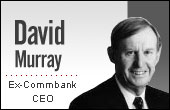CommBank: Tech chief recounts Murray era


The known technology critic and chief executive of the Commonwealth Bank, Murray will this week leave behind an interesting legacy after a 40-year tenure at the bank, including 13 years at the helm. Murray hands over the reigns to Ralph Norris, previously Air New Zealand chief executive officer, on Thursday.
Murray is best remembered for his scathing attack on technology a few years ago, having blamed the meltdown of the global economy on the United States' IT industry because of under delivery and over-promises.
On the cusp of a new management era at the bank, chief technology officer Sarv Girn shared his challenges in trying to please and keep up with Murray.
Like him, Murray's ambitious 'Which new Bank' transformation program, introduced in 2003, is also reaching its last chapter. The three-year, $1.5 billion initiative is a company-wide culture change exercise aimed at improving customer service response times -- said to be one of the worst amongst the large banks.
Initiated by the outgoing CEO, the program has included major technology projects such as the rollout of a new customer relationship management system, CommSee, and the recent relaunch of its online banking system, NetBank.
"We've had a fairly good strike rate on the big things that mattered," Girn told a banking technology conference in Sydney last week.
"We've got the unique customer identifier, we've got a complete view of customer holdings, customer contact information. We've made reasonable progress in some of the content-interface standards, which is a more usable service-oriented architecture capability.
"So all in all...quite a high strike rate," he said.
The Bank is to deliver 20 technology capabilities as part of the 'Which new Bank?' program, according to Girn. Alongside CommSee and NetBank, these include the rationalisation of wealth management systems, a new performance management system for staff, and renegotiated procurement contracts.
'Which new Bank' is expected to be complete by mid-2006.
"In terms of the CommSee platform, the branch platform, that's been rolled out. So that's complete and there are ongoing releases of that platform as you would expect from any system," Girn said.
Murray's departure would not create any change in project strategy, according to Girn. "David's moving off now, so we have a new CEO coming. So it's about maintaining the momentum we have as we get a new CEO in," he said.
"You don't just suddenly stop, the vision carries on."
That vision was not easy to realise in technology terms, however. Girn said Murray's 'Which new Bank?' mandate for IT was to "create one strategy for the bank, but make sure it can be realised".
The IT department developed their strategy, but at first found it "extremely difficult" to win Murray's support, he said.
"David's made, about four years ago, a lot of comments, particularly in front of the technology community, on his view of technology.
"It was difficult. The approach we used was really 'What could technology do from a financial perspective and also a customer service perspective'," he said.
"So we really put the full stop after his view and then said 'OK, well you've got that view, but this is what it can do when it's managed correctly'. So that vision was put to him and the vision of having one architecture."
The technology staff later won management buy-in, and support for their vision.
"It was basically driven by David over the last three of four years. So he's come around," Girn said.
The imperative to deliver on time and on budget also led the Bank to alter traditional business practices.
"We have a view that it's just not the IT strategy that needs to be in place to deliver to the corporate strategy," he said.
"To deliver the IT strategy you need two other things. An IT management, or operating model, which defines the roles and responsibilities...and coupled with that you need a sourcing strategy.
"One of the things we found was, for the 'Which new Bank' program we went through, we had to make some clear decisions upfront on the operating model, and where we were going to source the services from.
"In quite a lot of those instances they deviated from the traditional agreements we had in place. So yes the large CommSee platform was developed by inhouse staff, which is not what most people would have expected given most of our technology is outsourced to EDS."
Technology functions also changed internally.
"At the time we had one architecture department; we basically broke it up into two," Girn said.
"We had something called solution architecture emerging, which was really project level engagement to deliver the architecture.
"Through the solution architecture process, we brought in the development design expertise...from a data security infrastructure perspective.
"What was introduced here was a natural tension between long term direction standpoint and the needed imperative to deliver. That tension still exists, but it was one that was introduced on purpose to actually get that execution focus."
Despite the end to 'Which new Bank' looming, and a new CEO imminent, Girn again reiterated that there would be no major changes to the IT operations of CBA.
Rather, they would follow the same program, he said.
"In terms of where we are now...maybe most people think we're still in 'Which new Bank' and we're chugging along.
"We're now drawing towads the end of 'Which new Bank' and the final stages of implementation. As of two months ago, this cycle of vision and strategy started again. So some parts of the business are still in the implementation phase, and other parts are in the vision and strategy phase for the next cycle.
"Some people start saying 'Oh, Which new Bank 2', but I think as we go into the next few months we'll shape what has to be done in the next few years."